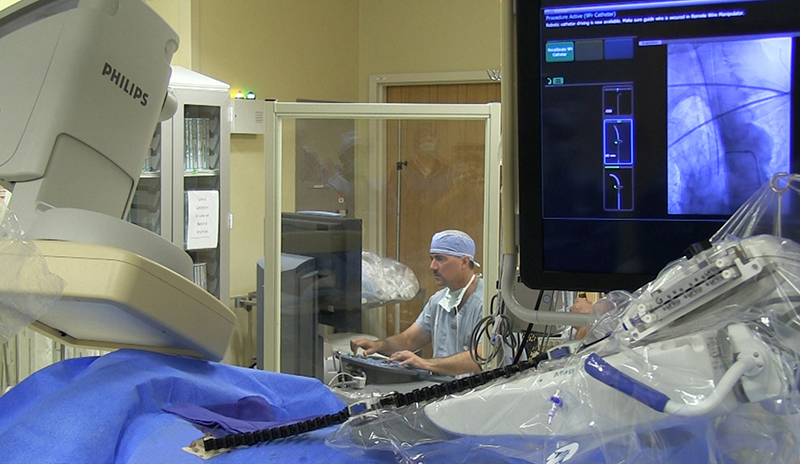Stroke Care Enters New Era with World's First Use of Robot-Assisted Endovascular Neurosurgery by Mayfield and TriHealth Neuroscience Institute
The Magellan™ Robotic Catheter System at the TriHealth Neuroscience Institute has a new destination -- the brain -- thanks to Andrew Ringer, MD, a neurosurgeon with Mayfield Brain & Spine and TriHealth Chief of Neurosciences.
The Magellan, acquired through a generous donation to the Good Samaritan Foundation, has been used since 2014 to treat vascular disease of the aorta, carotid arteries, renal arteries, and lower extremities. But after being introduced to the technology, Dr. Ringer suggested that the robot could also help surgeons perform endovascular (in-the-artery) procedures through winding, hair-pin vessels of the brain.
After Dr. Ringer and his colleagues began using the Magellan in February 2015 to perform 1) diagnostic angiography to acquire an x-ray of blood flow in an artery; and 2) intracranial intervention to break up clots inside the arteries of emergency stroke patients, he began partnering with the manufacturer, Hansen Medical, to develop new technology specifically engineered for intracranial use. Since that time, Dr. Ringer and his team have diagnosed or treated more than 50 patients with the help of robotic technology at Good Samaritan Hospital.

The results have the potential to change the future of stroke care. Dr. Ringer and his team were able to demonstrate that robotically assisted cerebral angiography and intervention are safe and technically feasible, with no significant difference in mean procedure times, the time spent under fluoroscopy (continuous, real-time x-ray), or the volume of contrast agent needed to visualize the arteries. In none of the cases did the surgeons abandon use of the robot in order to continue the procedure manually.
Equally important, because the robot can be controlled remotely, it has the potential to facilitate acute stroke intervention for patients who do not have immediate access to a comprehensive stroke center.
"Imagine a day when someone with an acute stroke doesn't have to wait to be transferred to me for a thrombectomy procedure, but can just go down the hall from the emergency department to the angiography suite, where I control the procedure from where I am located at that time," Dr. Ringer says. "This could allow us to provide treatment an hour earlier in many cases."
The first in the world to document a prospective case series of robot-assisted cerebral angiography and intracranial intervention, Dr. Ringer and his team published results of the first 23 patients April 2017 in the journal Neurosurgical Focus. Christopher Carroll, MD, co-author and neurosurgical resident at the University of Cincinnati, presented the case series at the annual meeting of the American Association of Neurological Surgeons in Los Angeles in April.
The timing could not be better.
"Results from a new stroke trial were released that indicate that even more patients may benefit from stroke interventions than we thought," Dr. Ringer says. "This trial, the DAWN trial, shows that some patients whose stroke is still small on specialized imaging might benefit for as long as 24 hours after their stroke. This will increase the need to make endovascular treatment available to patients, and we want to lead the way in making this care more accessible."
Technological advances have made the role of endovascular treatment for acute stroke increasingly important. For years stroke specialists had dreamed of being able to move quickly and aggressively to remove bulky, large-vessel blood clots, which may account for as many as half of the 630,000 ischemic strokes suffered by Americans each year. Because large clots cannot be easily dissolved with medication, patients who suffered such blockages were at grave risk of dying or suffering profound disability.
Endovascular specialists were still waiting as recently as 2013, when a multi-center trial (Interventional Management of Stroke III) found that patients had no better outcomes with IV medication than with direct treatment of the clot. But even as those results were being published, clot-retriever technology was maturing. And in January 2015 researchers demonstrated for the first time that patients with clots blocking large vessels had better outcomes when the clots were extracted with an endovascular device than when treated with medication alone.
"Our ability to leverage the Magellan for intracranial care is occurring at an opportune time," Says Dr. Ringer. "It coincides with technological improvements in the safety of device design, navigation, image transfer, and remote communications. As those pieces come together, the promise of Magellan is that it may enhance clot-retrieval technologies by making them available to more patients in our community, the region, and around the world."
In addition to Drs. Ringer and Carroll, co-authors of the Neurosurgical Focus paper are Shawn Vuong, MD, Ryan Tackla, MD, and William Jeong, MD. All were residents at UC at the time of the study.
Disclosures: Dr. Ringer and his team have no financial relationship with Hansen Medical.
Mayfield Brain & Spine is the full-service patient care provider of the Mayfield Clinic, one of the nation's leading physician organizations for neurosurgical treatment, education, and research. With more than 20 specialists in neurosurgery, interventional neuroradiology, physical medicine and rehabilitation, and pain management, Mayfield Brain & Spine treats 25,000 patients from 35 states and 13 countries in a typical year. Mayfield physicians specialize in the treatment of back and neck pain, sciatica, Parkinson's disease, essential tremor, NPH, epilepsy, brain and spinal tumors, stroke, moyamoya, brain aneurysms, Chiari malformation, scoliosis, kyphosis, facial pain, facial twitch, trauma, concussion, spinal cord injury, and carpal tunnel. As leading innovators in their field, Mayfield physicians have pioneered surgical procedures and instrumentation that have revolutionized the medical art of neurosurgery for spinal diseases and disorders, brain tumors, and neurovascular diseases and disorders.

